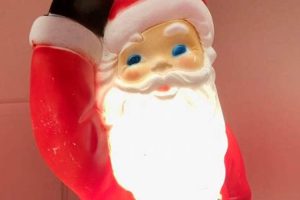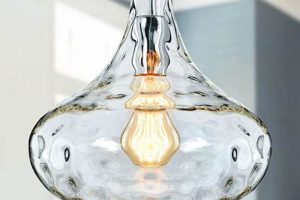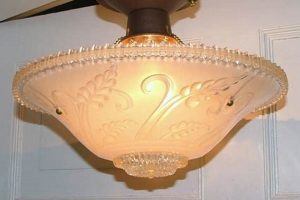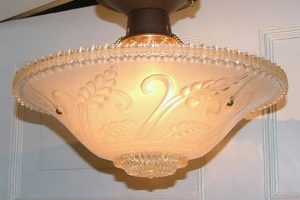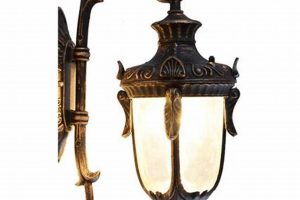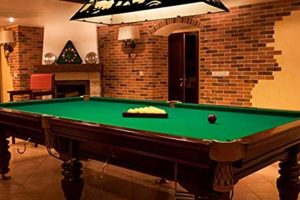These are a specific type of decorative lighting commonly used during the Christmas season. Characterized by their larger, generally conical or bulbous shape compared to miniature lights, they evoke a sense of nostalgia and a design aesthetic popular in the mid-20th century. They typically feature a screw-in base and come in a variety of colors, adding a classic visual appeal to holiday displays. Examples might include strings of multi-colored bulbs adorning a house’s eaves or outlining a Christmas tree.
The significance of these lights lies in their ability to recapture a traditional holiday ambiance. Their larger size and distinctive shape offer a visual impact that differs from modern, smaller lighting options. Furthermore, they often represent a connection to past celebrations and family traditions, fostering feelings of warmth and sentimentality. Their durable construction, common in older versions, speaks to a time when products were built for longevity, offering a sustainable alternative to disposable modern lights.
The following sections will delve deeper into the characteristics, historical evolution, potential restoration, and selection criteria related to these classic lighting fixtures. A discussion of common issues and potential solutions, along with resources for sourcing replacement components, will also be presented.
C9 Vintage Christmas Lights
The following provides critical advice for those seeking to acquire, maintain, or troubleshoot C9 lighting used for holiday decoration. Adherence to these points will ensure safety, longevity, and the preservation of this vintage aesthetic.
Tip 1: Inspect Wiring Meticulously: Prior to use, examine the entire length of the string for frayed wires, cracks in the insulation, or loose connections. Damaged wiring presents a significant fire hazard and should be addressed before powering the lights.
Tip 2: Verify Bulb Compatibility: Ensure replacement bulbs match the voltage and wattage specifications of the original lamps. Using incorrect bulbs can lead to overheating, premature failure, or damage to the wiring.
Tip 3: Employ Appropriate Fuses: Utilize the correct amperage fuse for the string of lights. Over-fusing negates the safety mechanism and can result in a fire; under-fusing will cause nuisance tripping.
Tip 4: Use Weather-Resistant Connectors: When using these lights outdoors, employ connectors designed to withstand moisture and environmental exposure. This will prevent corrosion and short circuits.
Tip 5: Limit Series Connections: Avoid connecting an excessive number of strings in series. Overloading the circuit can cause voltage drops, dimming, and potential overheating.
Tip 6: Store Carefully: During the off-season, store the lights in a dry, cool place, wound neatly to prevent tangling and damage. Protective containers can further extend their lifespan.
Tip 7: Consider LED Replacements: To reduce energy consumption and heat generation, investigate LED-based replacements that mimic the appearance of classic C9 bulbs. This offers a modern solution while retaining the vintage style.
These guidelines provide a foundation for the responsible and effective use of these decorative lights. By prioritizing safety and implementing proper maintenance, one can enjoy their aesthetic appeal for years to come.
The subsequent section will explore common troubleshooting issues encountered with these lights and offer practical solutions to address them.
1. Bulb Shape
The bulb shape is a defining characteristic of C9 vintage Christmas lights, significantly influencing their aesthetic appeal and historical accuracy. It’s not merely a cosmetic detail; it contributes substantially to the overall ambiance and reflects the design sensibilities of past eras.
- Conical Profile
The classic C9 bulb often features a distinctive conical shape, wider at the base and tapering towards the tip. This form disperses light in a broad, even pattern, creating a warm and inviting glow. Early iterations of C9 lights almost exclusively utilized this shape, making it a hallmark of authentic vintage sets. Replicas attempting to emulate this aesthetic must accurately reproduce this profile.
- Flame-Shaped Variants
Some C9 lights incorporate a flame-shaped bulb, mimicking the flickering appearance of candlelight. This adds a subtle touch of dynamism and sophistication to displays. While less common than the conical shape, flame-shaped C9 bulbs represent a distinct design choice, often associated with more elaborate and decorative lighting arrangements.
- Round or Globular Forms
Although the C9 designation typically implies a larger size and specific base, some vintage sets deviate with round or globular bulbs. These offer a softer, more diffused light output compared to the directional illumination of conical bulbs. Such variations reflect the diverse design trends prevalent during the mid-20th century.
- Surface Texture and Finish
Beyond the overall shape, the surface texture and finish of the bulb influence the light’s character. Smooth, clear glass provides a bright, unfiltered glow, while frosted or textured surfaces create a softer, more subdued effect. The finish, whether glossy or matte, also impacts the bulb’s appearance and contributes to the overall vintage aesthetic.
The interplay of these bulb shape variations underscores the importance of this element in defining C9 vintage Christmas lights. Whether replicating a specific era or curating a unique display, careful consideration of bulb shape contributes significantly to the authenticity and visual impact of these holiday decorations.
2. Wiring Integrity
Wiring integrity is paramount to the safe and effective operation of C9 vintage Christmas lights. Given their age and potential for degradation, a comprehensive understanding of wiring condition and its implications is crucial for users and collectors alike. Compromised wiring poses significant safety risks, including fire hazards and electrical shocks, and can also diminish the aesthetic appeal and functionality of these vintage decorations.
- Insulation Degradation
Over time, the insulation surrounding the wires can become brittle, cracked, or frayed due to exposure to heat, UV radiation, and physical stress. This degradation exposes the conductive core, creating a potential path for electrical leakage or short circuits. Visible signs of damage, such as peeling or discoloration, warrant immediate attention and repair or replacement of the affected sections.
- Connection Point Corrosion
The connection points where wires are joined or attached to the bulb sockets are particularly vulnerable to corrosion. Oxidation and the buildup of contaminants can increase resistance, leading to overheating and reduced light output. Regular inspection and cleaning of these connections using appropriate electrical contact cleaners are essential for maintaining optimal performance.
- Wire Gauge and Load Capacity
The gauge, or thickness, of the wire determines its ability to safely carry electrical current. Vintage C9 light sets may utilize thinner gauge wiring compared to modern counterparts. Exceeding the rated load capacity of the wiring by connecting too many strings in series can result in overheating and potential fire hazards. Adhering to manufacturer guidelines regarding the maximum number of connectable strings is imperative.
- Grounding and Polarization
Older C9 light sets may lack proper grounding or polarization, features that enhance electrical safety. Grounding provides a path for stray current to return to the source, reducing the risk of electric shock. Polarization ensures that the hot and neutral wires are correctly aligned, preventing potential voltage imbalances. Upgrading to polarized plugs or utilizing ground fault circuit interrupters (GFCIs) can improve the safety of these vintage lights.
These facets of wiring integrity underscore the need for meticulous inspection and proactive maintenance of C9 vintage Christmas lights. Prioritizing safety through regular assessments and appropriate repairs ensures that these decorative items can be enjoyed for years to come without compromising well-being. Neglecting wiring condition not only increases safety risks but also diminishes the historical value and operational longevity of these classic lights.
3. Color Palette
The color palette of C9 vintage Christmas lights serves as a potent indicator of their era and aesthetic intent. Specific color combinations, glass tints, and even the intensity of hues reflect the prevalent design trends of the time they were manufactured. Understanding the color palette, therefore, allows for a more informed appreciation and accurate restoration of these classic decorations. For instance, early examples often featured richer, deeper tones like ruby red, emerald green, and sapphire blue, achieved through the addition of metallic oxides to the glass during production. These colors were not merely decorative; they embodied the optimistic and affluent spirit of the mid-20th century, when such lights became increasingly popular.
The composition of the color palette also affects the perceived warmth and festive atmosphere. A balanced mix of primary colors creates a vibrant and cheerful display, while the inclusion of softer, pastel shades can evoke a more nostalgic and gentle ambiance. Moreover, variations in the color spectrum within a single string of lights introduce a dynamic visual element, enhancing the overall appeal. An example of practical application includes using vintage-correct hues to restore a string of lights to its original condition, preserving its historical accuracy and aesthetic value. Collectors and enthusiasts meticulously research and match colors to ensure authenticity, reflecting the significance of the color palette in preserving cultural heritage.
In conclusion, the color palette is more than just a decorative attribute of C9 vintage Christmas lights; it is an integral component that defines their historical context, aesthetic appeal, and cultural significance. Accurately identifying and replicating these color schemes is crucial for authentic restoration and for conveying the intended festive atmosphere. Challenges remain in sourcing exact color matches due to fading and changes in manufacturing processes over time. However, by understanding and appreciating the nuances of the color palette, one can better preserve and enjoy these iconic symbols of holiday tradition.
4. Socket Condition
The condition of the sockets in C9 vintage Christmas lights directly impacts their functionality, safety, and aesthetic integrity. These sockets, typically constructed from bakelite or other early plastics, are susceptible to degradation over time. Exposure to heat, moisture, and physical stress can cause cracking, chipping, and internal corrosion, rendering them unable to securely hold bulbs or conduct electricity effectively. For example, a corroded socket may exhibit increased electrical resistance, leading to dimming or complete failure of the bulb, and posing a potential fire hazard due to overheating. The type and extent of socket failure directly reflect on the overall state of the string of lights.
The importance of maintaining socket condition extends beyond mere functionality. Authentic vintage lighting relies on the preservation of original components, including sockets, to retain its historical value and aesthetic charm. Replacing damaged sockets with modern equivalents can detract from the authenticity and reduce the collectibility of the item. Restoration efforts often focus on cleaning and repairing existing sockets whenever possible, utilizing specialized tools and techniques to restore their electrical conductivity and structural integrity. One practical application includes carefully disassembling the socket, removing corrosion with a fine brush and appropriate solvent, and reinforcing any cracked or weakened areas with epoxy resin. Properly restored sockets not only ensure safe operation but also contribute to the accurate representation of the lights original design and craftsmanship.
In summary, socket condition is a critical factor in assessing and preserving C9 vintage Christmas lights. Degradation of sockets can lead to functional impairments, safety hazards, and a loss of historical value. Regular inspection, appropriate maintenance, and careful restoration techniques are essential for ensuring the longevity and safe operation of these classic decorative items. Challenges remain in sourcing authentic replacement sockets for certain models. Addressing these challenges contributes to the enjoyment and preservation of the historic significance of C9 lighting.
5. Era Authenticity
Era authenticity, concerning these lights, reflects the degree to which a string of C9 Christmas lights accurately represents the materials, manufacturing techniques, and design sensibilities of its original period. The preservation of such authenticity is paramount for collectors and enthusiasts seeking to recapture the nostalgic ambiance associated with vintage holiday decorations. These lights, when possessing demonstrable era authenticity, serve as tangible artifacts of cultural and technological history. This authenticity impacts the item’s monetary value, historical significance, and the emotional connection it evokes.
The components that determine era authenticity include the bulb construction, wiring materials (e.g., cloth-covered versus plastic-coated), socket composition (bakelite versus modern plastics), and even the paint used to color the bulbs. For example, a string of C9 lights manufactured in the 1950s would ideally feature glass bulbs with deep, vibrant colors achieved through specific chemical additives, sockets molded from bakelite (a phenolic resin), and wiring insulated with fabric. Deviations from these characteristics, such as the presence of plastic sockets or LED bulbs, diminish the item’s authenticity and its appeal to purists. The meticulous matching of replacement parts to original specifications is crucial in restoration efforts aimed at maintaining authenticity.
Achieving and verifying era authenticity presents challenges. Documentation of manufacturing processes from the mid-20th century can be scarce, necessitating reliance on expert knowledge and comparative analysis of known authentic examples. The effects of age, such as fading and degradation, can further complicate the identification process. Understanding era authenticity contributes to the responsible preservation and appreciation of these classic lighting fixtures, safeguarding their cultural and historical significance for future generations.
Frequently Asked Questions
The following addresses common inquiries concerning C9 vintage Christmas lights, providing definitive answers based on established knowledge.
Question 1: Are C9 vintage Christmas lights energy efficient?
Generally, no. Traditional C9 incandescent bulbs consume significantly more energy compared to modern LED alternatives. Their higher wattage translates to increased electricity costs and greater heat generation.
Question 2: Do C9 vintage Christmas lights pose a fire hazard?
A potential fire hazard exists, particularly with older sets exhibiting frayed wiring, cracked insulation, or loose connections. Regular inspection and diligent maintenance are crucial for mitigating this risk.
Question 3: Can C9 vintage Christmas lights be converted to LED?
Yes, LED replacement bulbs designed to mimic the appearance of traditional C9 bulbs are available. This conversion reduces energy consumption and heat generation while preserving the aesthetic appeal.
Question 4: How can the lifespan of C9 vintage Christmas lights be extended?
Proper storage in a cool, dry place, careful handling to avoid physical damage, and regular inspection for wiring issues will significantly extend their operational lifespan.
Question 5: Where can authentic C9 vintage Christmas lights be sourced?
Specialty antique stores, online marketplaces dedicated to vintage items, and estate sales are potential sources for authentic C9 vintage Christmas lights. Careful examination of condition and era-appropriate features is essential.
Question 6: How does one determine the age of C9 vintage Christmas lights?
Key indicators include the bulb shape, wiring materials (cloth versus plastic), socket composition (bakelite versus modern plastics), and the presence of specific manufacturing marks or labels. Consultation with a vintage lighting expert may be beneficial.
In summary, while C9 vintage Christmas lights offer a nostalgic appeal, their energy inefficiency and potential safety hazards necessitate careful consideration. Modern LED alternatives provide a safer, more energy-efficient option while preserving the classic aesthetic.
The subsequent discussion will present detailed troubleshooting advice for commonly encountered problems with C9 vintage Christmas lights.
C9 Vintage Christmas Lights
This exploration has underscored the multi-faceted nature of C9 vintage Christmas lights, moving beyond their surface appearance as mere holiday decorations. Examination of bulb shapes, wiring integrity, color palettes, socket conditions, and era authenticity reveals their value as cultural artifacts reflecting technological advancements and aesthetic preferences of past generations. The inherent safety concerns, particularly those associated with aging wiring and energy inefficiency, necessitate informed decision-making regarding their use and maintenance.
Given the considerations of safety, historical value, and environmental impact, individuals are encouraged to approach C9 vintage Christmas lights with a blend of appreciation and responsibility. Whether opting for careful restoration, LED retrofitting, or mindful display of original sets, the preservation of these lights becomes an act of cultural stewardship. The future enjoyment of these vintage lights relies upon an understanding of both their allure and their inherent limitations.


